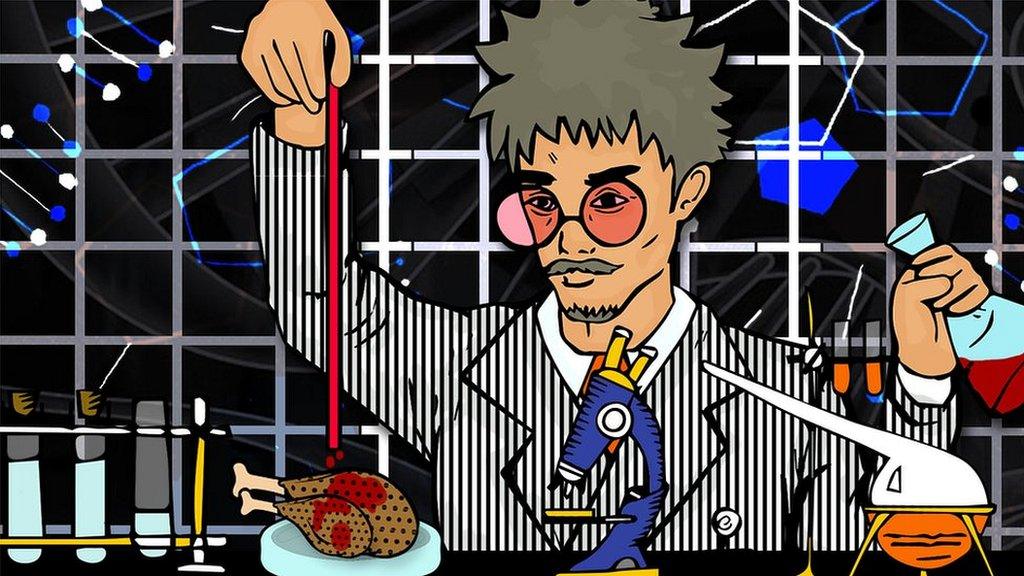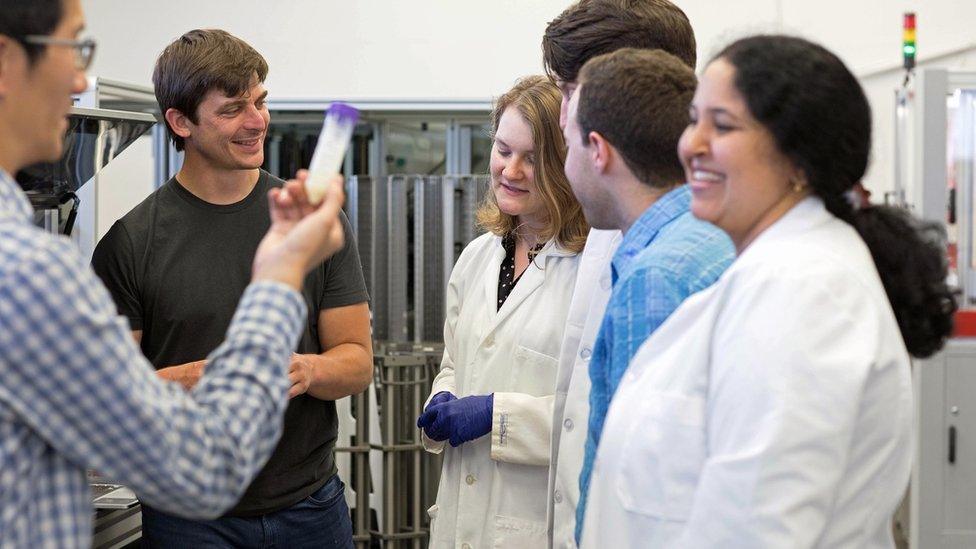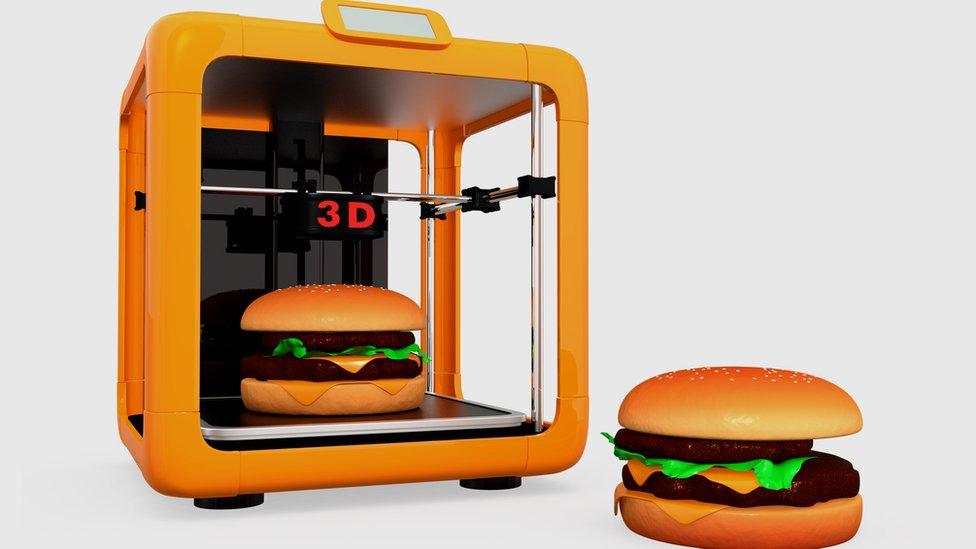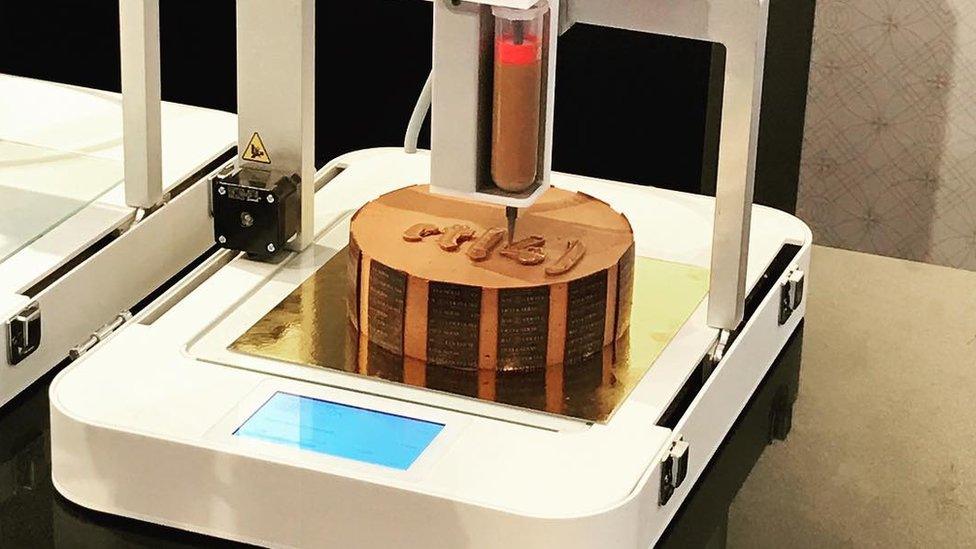Would you eat chicken grown in a lab?
- Published

With the world's population likely to reach 11 billion by the end of this century, there will be increasing pressure on farmers to maximise their use of agricultural land, and also on scientists to contribute to ensuring we all get enough nutrition.
The sci-fi food of the future could change the way we eat forever, and it is going to be up to food designers and marketers to convince us that it's not just an acquired taste.
In a lab in California, Josh Tetrick's team at Just, external has been growing chicken and foie gras. Maybe one day they'll have a steak blooming out of a petri dish too.
This is "cultured meat". Its very existence suggests a potential future in which meat is largely decoupled from livestock and agriculture. Instead, meat could be cultivated in laboratory-like environments; grown from progenitor cells like stem cells that produce muscle tissue, for example.
It seems as though in the future we'll need people to design food instead of grow or rear it.

Just's plans to have its first cultured meat products available to consumers later this year
"I want to do tuna, I want to do steak, chicken breasts, milk and butter," says Mr Tetrick.
"These are all things in our pipeline."
By the end of this year, he plans to have Just's first cultured meat product available in the food marketplace, perhaps the synthetic foie gras or sausages.

Mr Tetrick's hunch is that, for now, consumers will be interested only in synthetic meat that mirrors very closely the products that they're used to. If a synthetic chicken breast is essentially indistinguishable from a real one, it may well catch on.
But looking further into the future, once such products become established, it's possible that designers will bring even more adventurous concepts to our plates, suggests Erin Kim, of the future food research institute New Harvest.
You might start seeing elements of meat being incorporated into other types of foods - mixed with plant-based ingredients to produce a totally novel food products, she suggests.
All the flavour and protein of meat, but with less fat and a wider variety of nutrients. This is already being done in a simpler way with burgers that are a blend of beef and mushrooms., external
There is also the possibility that synthesised foods won't be produced on the scale you might expect - with millions of cultured chicken nuggets rolling off a production line. Maybe the technology will become democratised, enabling small-scale designers to experiment with interesting new products for niche audiences.

Fancy a burger? Why not just print it out
Like the craft beer industry but for meat, says Ms Kim.
Mike Lee at research group The Future Market, external recently developed a mock-up of a future Chinese restaurant menu with plenty of synthetic meat on offer. One of the "chef's specials" at Jia Rou Canting, external in the year 2042 is Cultured Shark Fin Soup.
"No sharks harmed", says the menu.
An interesting idea, though in reality some may fear that a market for synthetic shark fins could encourage a black market in the genuine articles. Today's shark fin industry is regularly accused of over-fishing.
Either way, giving food designers the opportunity to experiment with "artisanal takes" on lab-grown produce has lots of potential, says Ms Kim.

But the challenge in developing any new food is in making something that consumers are comfortable with. There's little that people are more cautious about that what they eat, says Max Elder, a researcher at the Institute for the Future, external.
"People don't want to eat science, they want to eat natural foods," he believes.
Take vegan mayonnaise. This is mayonnaise made with natural ingredients, including beans, which can be blended into a familiarly product but without the need for eggs. One such product is called "Not Mayo", and has been developed by a firm in Chile, external.
There may well be an important niche market among vegans - but this branding suggests that something else, something clever and futuristic, is going on.
In contrast, traditional mayonnaise producer Hellmann's recently launched a nostalgia-driven re-design of its packaging, external to move away from "bright, synthetic branding".

Dutch firm ByFlow is already selling its 3D food printers to restaurants
So will consumers stick with what's homely and familiar, or go for the food of the future? Max Elder thinks the former may be a savvier bet.
But that said, he believes future food designers may have success if they can develop foodstuffs that are what he calls "hyper-individualised" - crafted to give a specific person the exact nutritional content they need. No more, no less.
Dutch company ByFlow, external has come up with a 3D printer that prints food. Their model starts at 3,300 euros (£2,940) and the firm has already sold more than 100 of them, including many to professional restaurant kitchens.
The printer is loaded with cartridges full of edible pastes than can be designed to set when extruded, says ByFlow's Milena Adamczewska. It will print a carrot by using beetroot paste, for example.

Future of Work

BBC News is looking at how technology is changing the way we work, and how it is creating new job opportunities.

But taking the concept forward a step or two, imagine people in the near future using a 3D printer to produce meals with exactly the right calorie, fat, protein and vitamin content right for them.
The concept of highly tailored food intake is already popular with some dieters, external, but a more automated way of preparing these dishes could help to interest a wider audience.

Roast chicken, lovingly created in a lab just the way you like it
The role for a food designer here would be to create ways of tailoring consumables to each and every user - and finding ways of making extruded foodstuffs appetising once arranged together.
"Imagine that the cartridge is loaded with, let's say, all the nutritional elements that a single person needs," says Ms Adamczewska. It could even lead to a drop in food waste, she suggests, if people find it easier to purchase only the food they need to eat.
The possibilities are endless but just how many of us will embrace them remains to be seen, as food is one of a few things in our lives that we are notoriously reluctant to experiment with.